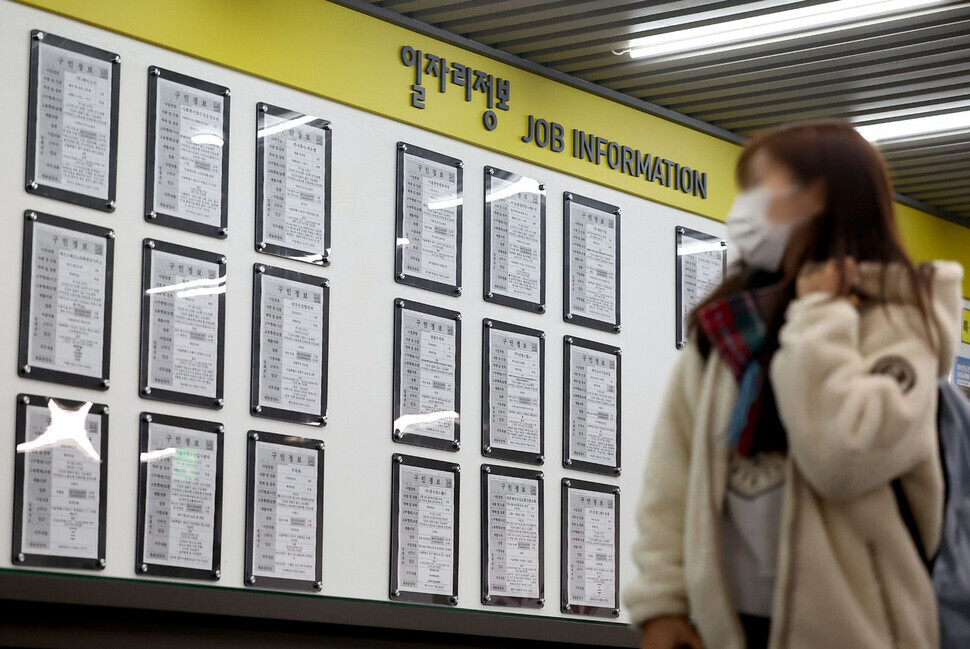hankyoreh
Links to other country sites 다른 나라 사이트 링크
[Editorial] Stagnant youth employment poses serious issues for Korea’s future

The number of employed persons in Korea increased in October by 346,000 year-on-year, pushing the overall employment rate up from 62.7% to 63.3%. However, the employment rate for young people aged 15-29 remained flat at 46.4% over the same period. This indicates a relatively large slowdown in the entrance of young people into the labor market. The number of young Koreans who are not actively seeking jobs is also on the rise.
Korea’s youth employment rate dipped to the low 41% range during the COVID-19 pandemic and has been recovering. A look at past statistics, however, shows that the youth employment rate for last month (46.4%) is still below the level of July 2004 (46.8%).
The slump is even more pronounced when compared to the overall employment rate for the population aged 15 and over, which rose from 60.6% to 63.3% over the same period. New job creation is focused on those aged 65 and over, and there’s little evidence of any improvement to the employment situation for young Koreans.
The number of people between the ages of 15 and 29 in Statistics Korea’s “Economically Active Population Survey” who said they were “taking a break” from looking for work in the past four weeks averaged 410,000 per month from January through October of this year.
Young people in these circumstances make up 4.9% of the total youth population, a number that had declined since 2020, when it reached 5%, but is recently on the rise. Three in 10 young people who said they were “taking a break” said they were doing so because it was difficult to find the job they wanted.
While prolonged youth unemployment is painful not only for the young people themselves, it also casts a dark shadow over South Korea’s future. The total fertility rate (the average number of children one woman capable of childbirth is expected to have over her lifetime) began to dip below 1 in 2018 at 0.98, dropping to 0.78 in 2022 and 0.7 in the second quarter of 2023.
At this rate, not only will the growth engine of the country weaken, but the system that keeps the country standing may well collapse.
On Wednesday, the government announced a plan to promote young people’s entrance into the labor market, including providing customized employment services to jobseekers, supporting the spread of youth-friendly corporate culture, and helping isolated and reclusive youth return to society.
These are projects reflected in this year’s and next year’s budgets, but they will not be enough. There is a lack of good jobs being created for young people amidst changes to the industrial structure and companies are avoiding providing learning opportunities for new entrants to the labor market by focusing recruitment on applicants with demonstrated experience.
It’s a structural problem, not one that can be easily fixed by providing small amounts of support or pressure on individual companies. Labor, management, and the government should brainstorm together to confront and seriously address the reality of Korea’s plummeting birth rate.
Please direct questions or comments to [english@hani.co.kr]

Editorial・opinion
![[Column] Season 2 of special prosecutor probe may be coming to Korea soon [Column] Season 2 of special prosecutor probe may be coming to Korea soon](https://flexible.img.hani.co.kr/flexible/normal/500/300/imgdb/original/2024/0426/3317141030699447.jpg) [Column] Season 2 of special prosecutor probe may be coming to Korea soon
[Column] Season 2 of special prosecutor probe may be coming to Korea soon![[Column] Park Geun-hye déjà vu in Yoon Suk-yeol [Column] Park Geun-hye déjà vu in Yoon Suk-yeol](https://flexible.img.hani.co.kr/flexible/normal/500/300/imgdb/original/2024/0424/651713945113788.jpg) [Column] Park Geun-hye déjà vu in Yoon Suk-yeol
[Column] Park Geun-hye déjà vu in Yoon Suk-yeol- [Editorial] New weight of N. Korea’s nuclear threats makes dialogue all the more urgent
- [Guest essay] The real reason Korea’s new right wants to dub Rhee a founding father
- [Column] ‘Choson’: Is it time we start referring to N. Korea in its own terms?
- [Editorial] Japan’s rewriting of history with Korea has gone too far
- [Column] The president’s questionable capacity for dialogue
- [Column] Are chaebol firms just pizza pies for families to divvy up as they please?
- [Column] Has Korea, too, crossed the Rubicon on China?
- [Correspondent’s column] In Japan’s alliance with US, echoes of its past alliances with UK
Most viewed articles
- 1‘We must say no’: Seoul defense chief on Korean, USFK involvement in hypothetical Taiwan crisis
- 2Why Kim Jong-un is scrapping the term ‘Day of the Sun’ and toning down fanfare for predecessors
- 3Two factors that’ll decide if Korea’s economy keeps on its upward trend
- 4After election rout, Yoon’s left with 3 choices for dealing with the opposition
- 5BTS says it wants to continue to “speak out against anti-Asian hate”
- 6AI is catching up with humans at a ‘shocking’ rate
- 7Noting shared ‘values,’ Korea hints at passport-free travel with Japan
- 8Gangnam murderer says he killed “because women have always ignored me”
- 9South Korea officially an aged society just 17 years after becoming aging society
- 10Ethnic Koreans in Japan's Utoro village wait for Seoul's help